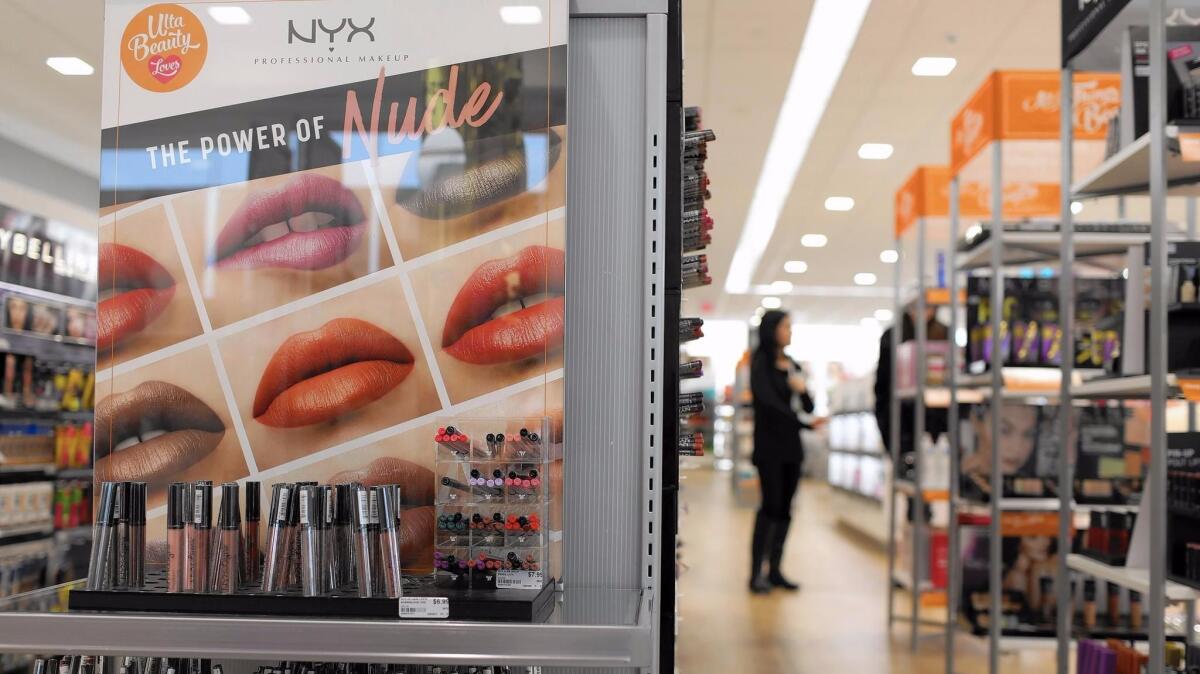Beauty companies hustle to keep up with faster trends

- Share via
When reality TV star Kylie Jenner introduced her first cosmetics products to the Internet in late 2015, the Kylie Lip Kits — matte liquid lipstick and lip liner combos — sold out in minutes.
Competing brands were paying attention. Companies quickly started promoting their own matte lipsticks as duplicates of the Jenner hues, hoping to win customers desperate to jump on the trend but unable get their hands on the sold-out products.
How quickly Jenner’s lipstick and look-alikes became a must-have demonstrates the impact of social media on yet another industry. People are discovering new looks online, and to keep up with demand for the next must-have, some beauty companies are taking a page from the fast-fashion playbook and moving quickly.
“We used to deal in trends that lasted five to 10 years,” said Karen Grant, beauty industry analyst at market research firm NPD Group. “Now, we think it’s a long trend if it lasts 24 months.”
One of cosmetics maker E.l.f. Beauty Inc.’s tactics is a fast-fashion-like approach to testing new items. Most products are first sold only at the Oakland-based company’s retail shops and online store. If they catch on — measured by sales, reviews and social media feedback — E.l.f. can quickly ramp up production and begin distributing to national retail customers, Chief Executive Tarang Amin said.
“Staying close to the consumer helps us know what trends and new products resonate with her. We believe this also provides us a much higher success rate compared to other brands when we expand distribution,” he said.
At any given time, E.l.f. has more than 200 ideas in the works and emphasizes “first to mass” items — either products that are entirely new, or versions of products sold by only higher-priced brands, such as a mineral-infused face primer inspired by prestige brands, Amin said. It takes about 27 weeks to turn an idea into a product for sale at E.l.f.’s website and stores, but can be done in as little as 20 weeks. The company went public last fall.
Bigger companies may not be as naturally nimble, but “they’re all trying to be part of the game,” Grant said.
Ulta Beauty Inc. is picking up the pace for its eponymous private-label brand. It requires suppliers to deliver some products in more trend-driven categories in no more than nine months, said Julie Tomasi, Ulta’s senior vice president of merchandising.
That might not sound speedy, but it’s a sprint compared with the 18 months it took Ulta two years ago. “In today’s environment, that’s a lifetime,” Tomasi said.
The Bolingbrook, Ill., company has gotten “a very good return on investment” in efforts to speed up product development, she said. “It makes us more relevant to guests. Instead of being more trend reactive, we’re a little further ahead.”
Fast-fashion retailers such as Zara and H&M, which began training customers to expect ever-changing on-trend styles at relatively budget-friendly prices, have been a major source of pain for more traditional apparel makers already struggling with the impact of e-commerce.
But analysts say old-school beauty companies might not have as much to fear as apparel sellers. That’s partly because the pool of people trying to keep up with every new look seems smaller in makeup than in apparel, said Giulia Prati, associate director of beauty research at research firm L2.
Even Grant — who likens the market full of “little upstarts trying to topple the giants” to the roster of schemers scrabbling for power in “Game of Thrones” — isn’t expecting upheaval.
The influx of new brands and products and faster-shifting trends is boosting overall spending on makeup, meaning there are more dollars to go around, Grant said. Within the entire prestige beauty segment, makeup sales were up 12% last year and accounted for 82% of overall growth in 2016, according to NPD. In the lower-priced mass-beauty market, makeup and skin care products contributed equally to overall sales growth.
A 2016 survey by Mintel found that for every shopper who thinks it’s fun to check out new, smaller brands she spots on social media, there are two like Bonnie Lavoie, happy with products they use on a regular basis.
“I’ve got something that works for me, and I stick with it,” said Lavoie, 67, who lives in Joliet, Ill.
Even if some old-school brands fail to keep up with the industry’s pace and suffer as a result, the companies behind those brands are hedging their bets by buying up younger, trendier brands.
L’Oreal bought NYX in 2014, and Estee Lauder picked up Too Faced in a $1.45-billion deal in November. Estee Lauder said the brand — known for mascara called Better Than Sex — had grown sales 70% that year and would help Estee Lauder “win with millennials.”
Price tags have been “very high,” Prati said, but it’s a way for legacy companies to get a cut of the newcomers’ growth while trying to learn from their playbooks.
“It’s kind of a wake-up call for legacy beauty brands,” Prati said.
ALSO
Obamacare 101: Are health insurance marketplaces in a death spiral?
Trump’s promise to ramp up deportations spreads fear — among California businesses
More to Read
Inside the business of entertainment
The Wide Shot brings you news, analysis and insights on everything from streaming wars to production — and what it all means for the future.
You may occasionally receive promotional content from the Los Angeles Times.










